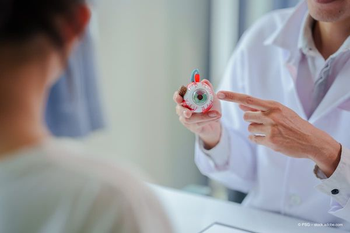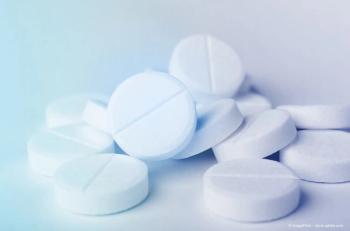
Oral therapy may be viable for CSC
A short course of oral mifepristone may reduce or improve subretinal fluid and improve best-corrected visual acuity (BCVA) in patients with chronic or recurrent central serous chorioretinopathy (CSC), said Roger Goldberg, MD, MBA, with Bay Area Retina Associates.
There are numerous risk factors for CSC, including being Type A personality, systemic hypertension, Cushing syndrome, pregnancy, organ transplantation, allergic respiratory disease, or autoimmune disorders.
Mifepristone is a potent, glucocorticoid steroid antagonist and because CSC is associated with either excessive endogenous cortisol and epinephrine levels, or excessive exogenous cortisol that affects the autoregulation of choroid circulation, mifepristone is a natural possibility to consider for treatment of CSC.
"It is thought that excess cortisol levels in pre-disposed individuals affects the choroidal circulation and autoregulation," Dr. Goldberg said. "This suggests that if we can inhibit or block the effect of steroids, we might be able to offer a treatment to these patients."
Mifepristone binds to cystolic glucosteroid receptors and prevents gene expression, but it is also a progesterone antagonist. The compound has a high oral bioavailability with an acceptable side effect profile, Dr. Goldberg said
In the U.S., the compound has been approved for use in two separate indications, one as an abortifacient (RU-486) in a lower dose (200 mg) and for Cushing syndrome with a 300 mg dose.
STOMP-CSC
STOMP-CSC was a randomized, placebo-controlled, double-masked, multicenter, investigator-initiated study (ClinicalTrials.gov ID NCT02354170).
"There was no corporate oversight or data control," Dr. Goldberg said, although Corcept did provide the study drug kits.
The study enrolled 30 patients, randomized to mifepristone 300 mg daily, mifepristone 900 mg daily, or placebo. Patients were dosed for 4 weeks, and then observed for an additional 4-week washout period. At baseline, 4 weeks and 8 weeks, optical coherence tomography (OCT) angiography was used to assess treatment outcomes.
The investigators thought it imperative to include a true placebo arm as this disease has a known waxing and waning nature, and in these pre-disposed patients there may be a true placebo effect, he said.
The primary outcome was the change in central retinal thickness (CRT) on OCT. Key secondary outcomes were the change in BCVA as measured on the Early Treatment Diabetic Retinopathy Study (ETDRS), safety, and tolerability.
Key inclusion criteria included a diagnosis of persistent or recurrent CSC, with symptoms that had been ongoing for at least 6 weeks and the presence of subretinal fluid in the central foveal subfield on spectral-domain OCT, among others.
Key exclusion criteria included women who were breastfeeding, pregnant, or actively trying to conceive; patients with active intraocular inflammation; patients who required concomitant treatment with systemic corticosteroids for serious medical conditions (i.e., immunosuppression after organ transplant), among others.
Study Results
There were a total of 30 patients enrolled, but one was excluded from the efficacy analysis after OCT revealed no subretinal fluid on central subfield. The average age of enrolled subjects was 54 years, and there were 25 men/5 women enrolled. The patients had an average duration of CSC of 5.3 years.
"Did mifepristone affect the central retinal thickness? Well, it certainly seemed to," he said. "Patients who were treated with active treatment, either 300 mg or 900 mg, had a statistically significant reduction in their subretinal fluid."
The mifepristone groups had a baseline CRT of about 351 μg that decreased to about 312 μg at 4 weeks (p = 0.04), while the placebo group had a baseline CRT of about 355 μg that decreased to about 340 μg (p = 0.45).
The comparison between the active and placebo arms did not reach statistical significance (p = 0.15) but Dr. Goldberg attributed that to the small number of patients enrolled.
"The VA results correlated very nicely to the CRT outcomes," he said. "Patients in the mifepristone arms gained 3.6 letters (p<0.05) compared to the placebo group that gained 0.7 letters (p=0.64)." Between group comparisons did not reach statistical significance (p = 0.19).
At baseline, 83% of patients had a baseline BCVA ≥ 20/40, which "may have produced a ceiling effect on the change in BCVA," Dr. Goldberg said.
The drug was well tolerated, with nausea/dizziness the most common adverse event reported in the mifepristone arm (n = 4; 20%), followed by back pain and headache (n = 3 each; 15%), but these were mild and transient, Dr. Goldberg said.
"There are certainly some limitations and key learning points," he said.
For example, the study had a small sample size, which may have resulted in a true placebo effect. After enrollment, the researchers identified one patient with choroidal neovascularization membrane on OCT, which should become an exclusionary factor in the future.
"This really speaks to our need for other functional endpoints beyond BCVA," he said. "These patients are highly symptomatic and many of them have a ceiling effect because the baseline vision was so good. Or there was a basement effect - they had such severe disease that despite the anatomic improvement, it was impossible to show visual improvement." He advocated for larger studies.
Disclosures:
Dr. Goldberg is an investigator for Corcept Therapeutics.
Newsletter
Keep your retina practice on the forefront—subscribe for expert analysis and emerging trends in retinal disease management.











































